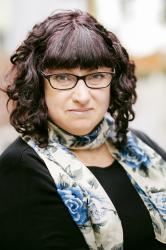Like A Fishbone
As writer Anthony Weigh states in his notes in the program for Like a Fishbone, the play is structured around three main ideas or events. First and foremost is the idea of memorialising the dead.
Sydney Theatre Company and Griffin Theatre Company
Wharf 1, Sydney Theatre Company
Tuesday, 20 July, 2010
As writer Anthony Weigh states in his notes in the program for Like a Fishbone, the play is structured around three main ideas or events. First and foremost is the idea of memorialising the dead. Taking inspiration from a quote left by a grieving mother at the Twin Tower’s memorial site after the September 11th tragedy, Weigh delves in to the idea of a memorial leading us to look up into the heavens, remembering the lost as heroes, rather than looking down into the earth. This first point then bleeds into the second; the eternal debate over the importance and relevance of God in our lives, versus the atheist belief in human truth above all else. The final issue, is feminism. All three points are embodied and debated through the two main characters of the Architect, played by Marta Dusseldorp, and the Grieving Mother, played by Anita Hegh.
Like a Fishbone looks at the aftermath of a tragedy on a small town, and the way in which memorialising the dead can mean such different things to different people. The story centres around two women, the architect commissioned to design the memorial, and mother grieving for her lost child, waging a personal battle between religious faith and humanism, grief and commemoration. Both are struggling to make sense of senseless violence, whilst figuring out how to remember those we have lost, and how to move on.
At first glance, these three central components seem like issues that have been manipulated, played with and studied to death through the arts, however the strength in Weigh’s script is in its ability to once again allow us to view these issues in a new light. Weigh is proposing questions, without divulging clear answers, thus leaving the audience to contemplate their own definitions and answers based on their own beliefs and ideas. Despite this, it did seem as though many of these thoughts and ideas were left under-developed; nearing a point of enlightenment but stopping just short. The characters, whilst played with courage and commitment by the actors, just didn’t quite reach far enough beyond stereotyped embodiments of these issues: the Architect; a workaholic, divorced, atheist with her own business and a view to shatter the glass ceiling; and the Grieving Mother; a modestly dressed, plain, Evangelical, small town girl, reformed from a past of drugs and abuse.
Having said this, carrying a 90 minute play with just four actors (one, The Girl, makes only a cameo appearance as a ghost at the end of the play) is no easy task, and Marta, Anita and Aimee Horne, The Intern, manage this with great energy, commitment and grace. Marta Dusseldorp makes the stand out performance, bringing a sense of flair, wit, and just the right amount of crazy to the character of the Architect.
The direction, done by Tim Maddock, takes on a deliberately high energy, fast talking, notch above naturalism approach, which works well in highlighting the issues for contemplation. Whilst the play did manage to keep the audience thoroughly engaged throughout, it could have benefited from slightly more variation in tempo and style of delivery. Many lines were delivered simultaneously by both characters, which, done once or twice can be an effective technique, however in this instance was over-done and led more to confusion than emphasis.
The ideas presented within this play are definitely not anything new or particularly prophetic, however Weigh has definitely proposed these questions with interesting and insightful inflections. Disappointingly, it seemed as though these ideas were mostly underdeveloped. A glance over the writer’s notes in the program confirmed for me that Weigh’s intentions were definitely worth attention, however I wish they had been that clear in the play.
The main issue that I repeatedly encounter in plays predominated by two characters, is that there seems to be a challenge in overcoming ‘the perpetual argument’. Like watching a tennis match, the perpetual argument bats back and forth, seemingly with no end in sight, until you are no longer sure of who is arguing what.
Carrying a 90 min shows with 3 main actors is never an easy task, but Marta Dusseldorp and Anita Hegh managed this with great energy, commitment and grace. Marta was fantastic in the role of the Architect, presenting the characters with a sly wit, subtle but impeccable comic timing, and just the right amount of crazy.
All in all I think this is an interesting play, definitely worth seeing as every audience member will gain different insight and meaning from the show.
Season Closed

